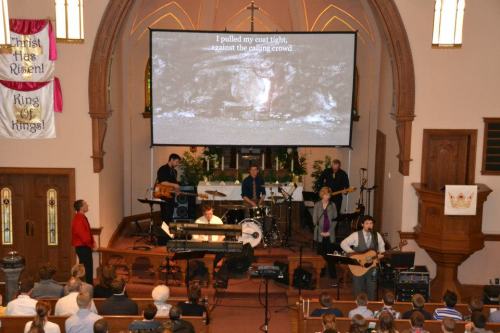Here is a recent picture from my former congregation. What does this picture say?
The baptismal font in the lower left corner shows that there was a baptism. So this was not a concert. The pastor was wearing red. The liturgical color of white for Easter was being displayed. The altar and a statue of Jesus were covered up by a big screen TV. (Normally, in this congregation, only the unused pulpit is covered by a TV screen). What else does the picture say?
The Facebook caption for the photo is: “Sunday Worship with Koine.” (Built on the Rock, St. Peter Lutheran, Appleton, WI). Koine is known for playing only hymns out of the hymnal, but the lyrics displayed on the screen say: “I pulled my coat tight, against the calling crowd.” That doesn’t sound like a hymn, but who knows.
This picture has captured some attention on the internet. For example, LCMS Pastor Todd Wilken (the host of Issues, Etc.) used the picture as “a general illustration of how contemporary worship distracts from the focus on the Word and Sacraments.” (The Bare Bulb, “An Act of Aggression,” comment). Does this picture illustrate how contemporary worship distracts from the means of grace, or does it illustrate genuine Lutherans using all their God given gifts to the best of their ability?
---
Todd Wilken:
http://thebarebulb.com/2013/04/27/an-act-of-aggression/comment-page-1/#comment-323
---
Todd Wilken:
http://thebarebulb.com/2013/04/27/an-act-of-aggression/comment-page-1/#comment-323
The worship war is not a bilateral conflict; it is a unilateral act of aggression.
One side in this conflict has consistently adopted an aggressive posture; the other side, a defensive one. One side has advanced; the other side has fallen back and retreated. It has been less a worship war, and more a worship invasion.
The worship war is a unilateral act of aggression, planned and pursued by those insisting on change, innovation and often the wholesale abandonment of historic Christian worship. Very few worship warriors on that side realize or admit this, but this is their proven track record for the last half-century.
The aggressors have the best intentions. They sincerely believe that their aggression has been to advance the Kingdom of God and spread the Gospel. I do not question their motives; I question their results.
Has the result been more or less focus on Christ and his saving work on the Cross for sinners? Has the result been more or less focus on God’s divine means of Grace –Baptism, Absolution, the Lord’s Supper? Has the result been more or less proclamation of the essential Christian message –repentance and the forgiveness of sins in Christ’s name?
In other words, have 50 years of worship war advances resulted in a clearer confession of the Gospel on Sunday Morning?
No, they haven’t.
This post is an edited excerpt from Behind the Music: The Real Worship War.




It is unclear whether this was a Sunday worship service or a concert. In either case, the picture confesses what it confesses. TW
The worship war is larger than the LCMS. And, Lutheran history did not begin with the LCMS. TW
This was not a communion Sunday. Communion was offered several other times this month.
“During this transition he has already begun to work on projects to improve the quality of the worship experience. A new platform is being built to extend the choir/band riser closer to the chancel. This will allow singers and musicians to be more connected to the congregation. A plan is being put together to move the loudspeakers to a center cluster that will make the sound system more intelligible.”
The thing is, I can do Low Church and still hold to the historic Confessions – I always have. You make out that it must be an either/or. Maybe that is your testimony, but it might not be everyone else’s.
Another thing, people often adopt the attitude of “the fox and the grapes.” If God hasn’t allowed you to experience a miraculous healing, for example, it must be that He o longer heals miraculously. I have friends who have that perspective, and, when it got down to it, that was the root of it. Someone whom they dearly loved died instead of got healed in response to prayer.
AGain, I’m wanting to be charitable here; consider that there might be something in some of those “charismatic/pentecostal” expressions that touches the emotions. God DID, after all, create us with bodies, so He gave us tangible sacraments to taste and see that the LORD is good. Could He not have also blessed us with worship forms that allow us to express our joy? If it would not be too much trouble, try googling the Hallelujah Chorus arranged by Quincy Jones. It IS the same song, but with a style that is probably different from what you are accustomed to.Tell me what you think of it. That is what I have in mind, although I understand what you are concerned about. Also, you might consider that Luther was not trying to overthrow Roman Catholicism, as much as prune it back. That governed his actions as much as anything else.